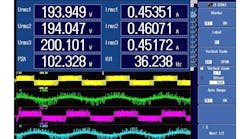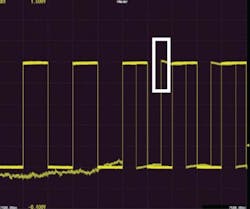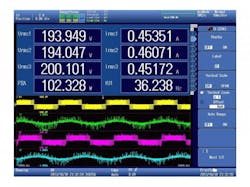What do you get if you cross an oscilloscope with a power analyser?
What do you get if you cross an oscilloscope with a power analyser? Well, you get the Yokogowa PX8000, is the short answer. The long answer is a bit more involved. Essentially, Yokogowa has combined the real-time functionality of an oscilloscope with the accuracy of a power analyser. The aim is to capture current and voltage waveforms with high accuracy, in order to identify those difficult-to-spot transient signals that may disappear in a fraction of a second. This is something oscilloscopes haven’t been accurate enough to do, up to now.
The resulting instrument, the PX8000, is being billed as the ‘world’s first precision power scope’ – it has 100 MS/s sampling and 20 MHz bandwidth, and can measure up to 1000 V RMS and 5 A RMS with a basic accuracy down to +/-0.1%. Its real-time power sampling capability is rather special; it has four inputs and can simultaneously capture and display voltage and current across all three phases.
The thing about transients is they are just that – transient – they disappear from the screen almost as soon as they appear. The PX8000 has an always active history function that records the last 1000 waveforms, so you can recall them at any time to look for anything abnormal, even searching them based on conditions. You can also use a stored waveform to redefine trigger conditions.
Yes, you could use an oscilloscope to look at power waveforms, but accuracy would be limited to 5-10%. That may be OK for initial work but not for something that requires greater accuracy like testing to standards. Temperature stability is also a concern; there is potential for relatively large errors to creep in.
On the other hand, a power meter may not be suitable as it measures the average power over a cycle, albeit with more accuracy than the PX8000. Power meters that show waveforms are available, but according to Yokogowa’s Clive Davis, these waveforms aren’t shown with much accuracy as the meters are designed to show numbers only.
When asked if some combination of a scope and a power meter could be used, Davis said it would be extremely complex to synchronise the two instruments to look for such fast transients. He also pointed out that you may not realise that what you’re doing is affecting the signal, complicating things further.
Ultimately, traditional power meters are not designed to provide accurate time measurements, and oscilloscopes are not designed to measure power - hence the introduction of this hybrid instrument, with which Yokogowa is hoping to offer the best of both worlds.


